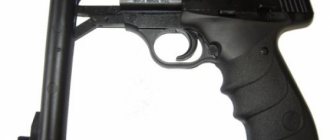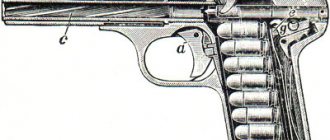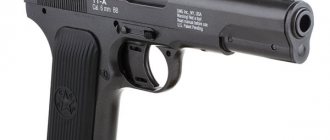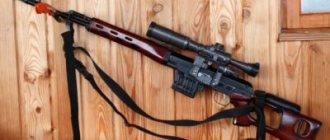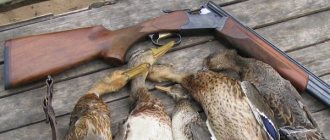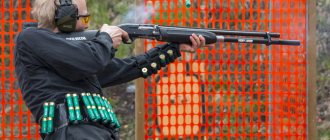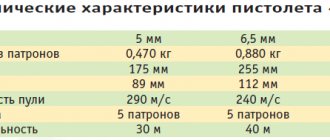Brownings are the world's first portable self-loading pistols, known from many books, which have gone down in world history as a weapon of the most resonant murders and assassinations. The brainchildren of John Moses Browning were used to shoot at the Prime Minister of Tsarist Russia Pyotr Stolypin, the leader of the USSR V.I. Lenin, Archduke Franz Ferdinand, French President Paul Doumer... Each new weapon model was in great demand and served as the basis for the development of other designers, including the author of the legendary Soviet "TT" F.V. Tokarev.
We'll tell you the history of Browning pistols, analyze their design, compare the features of different models, identifying their pros and cons.
History of the creation of Browning pistols
Browning John Moses began his career in his homeland, the USA, but the Browning pistol, which brought eternal glory to the inventor, was patented (FN), registered in Belgium. It became the first and largest Browning manufacturer in Europe.
It was Mr. Browning who was the author of the automatic operation schemes that formed the basis of self-loading pistols and continue to be used in the new millennium:
- using the recoil of the barrel during a short stroke and locking the bolt by tilting or turning the barrel;
- using blowback recoil;
- using the removal of powder gases.
Based on the first two schemes, the designer personally created pistol models that were put into mass production and gained enormous popularity. At one time, all portable multi-shot pistols were called “Brownings” in Russia, just as any revolvers were called “revolvers.”
The designer began developing a self-loading pistol in 1895, and two years later filed a patent for this invention. When creating the classic model, the inventor used a blowback shutter circuit.
In 1898, he first presented a pistol of his own design, and the aforementioned Belgian company undertook to produce it, which managed to produce 3,000 copies. In 1900, an improved design appeared, which is called the Browning M1900.
Trigger system
The design of this unit in the Browning M 1918 provides for single and automatic fire. After locking the barrel, the liner strikes the firing pin in the bolt. Before closing, the locking lever prevents the striker from passing through, and after opening it is retracted. Thus, the set of the above parts forms a kind of automatic fuse.
The trigger mechanism is equipped with a buffer spring mounted on the frame. It is located in the middle of the trigger box. After pressing the trigger, the disconnector connected to it raises the front edge of the lever, removing the bolt frame from the firing position.
Pistol design
This is what an 8-round Browning looks like from the inside.
The classic Browning is created as a generally self-loading firearm, the automatic component of the design of which is based on a blowback mechanism with replaceable magazine feed.
The barrel of the pistol is securely fastened and remains motionless when firing. The sight is open type, non-adjustable. The magazine release is located at the bottom of the handle at the rear. The magazine capacity depends on the modification of the Browning, the minimum is seven rounds.
The return spring is located above the barrel itself. Its rear end puts pressure on the firing pin, making the spring at the same time a combat spring.
The pistol is equipped with a manual safety, which is located on the frame, on the left side.
general information
The design of the Browning Automatic Rifle (BAR) machine gun is based on the Vickers-Berthier system of the 1908 version with some modifications. The barrel in the box is fixed with a thread, which does not allow quick replacement of the element in combat conditions. The same unit was equipped with a smooth sleeve-type muzzle extension. Initially, the channel had five, and then four grooves on the left side, the stroke of which was 254 mm.
The automation functioned by removing exhaust gases from the barrel channel. The working chamber is of a closed configuration; the regulator has three holes and is screwed in directly in front of the guide tube. A swivel clamp and a forend made of wood with a notch are attached to it.
Browning pistol models
Browning M1900
The first Browning model - M1900
Model 1900 was produced in two versions - with a 102-mm and 122-mm barrel length. A pistol with a 102-mm barrel gained enormous popularity, which was immediately adopted by the Belgian army, and a year later entered the arsenal of the Belgian gendarmerie, and in 1903 - the police of several European states.
In the Russian Empire, officers were allowed to buy both models, designated “Browning No. 1” and “Browning No. 2”, with personal money, and carry them instead of a revolver. The same could be done with subsequent models of the famous pistol.
Browning M1903
Browning M1903 with Holster - 9mm
The main improvements to the Browning pistol, modeled in 1903, were:
- The use of a 9x20 mm cartridge instead of 7.65x17 mm;
- Transferring the return spring under the barrel;
- Changing the mainspring to a separate flat part located on the handle on the back side;
- The appearance of a plate safety device placed on the back surface of the handle, which blocks the trigger, excluding spontaneous shooting, and is turned off by a strong grip of the handle;
- The trigger mechanism is hidden inside the casing.
It is noteworthy that in 1903, along with the seven-round Browning, a modification with a 10-round magazine first appeared.
Improvements led to a significant weighting of the weapon - from 625 to 910 grams. The few variations with a wooden holster-butt, which increased accuracy and accuracy, weighed even heavier.
The main production of Brownings continued to be carried out by the FN company, but after the First World War, production began in Sweden, at the Husqvarna site, under the designation 9 mm Pistol M/07. The Model 1903 was used by armies of many countries.
Browning M1906
“Women’s” Browning of 1906, which was eagerly used by men
In 1906, the first pocket Browning went into mass production, which was nicknamed “female” for its special characteristics - minimal dimensions and weight of 380 grams.
The caliber of the weapon was reduced to 6.35 mm, and the magazine capacity was reduced to 6 charges. In this case, the general design features were the same as for previously developed models.
The Browning M1906 gained even greater demand - by 1914, when its production ceased, approximately 1.2 million units had been produced. Later, such “pestles” were produced by Colt and small firms in Spain.
Ladies' Browning helped the Soviet designer S.A. Korovin to create a TK pistol chambered for 6.35×15 mm, which for some time served as a reward weapon, entered service with NKVD officers, party workers and civil servants, and served the cause of collection and protection of savings banks.
FN – Browning 1910
FN Model 1910 - seems to be the same classic Browning, but significantly improved.
In 1910, the FN Model 1910 was designed, designed to replace the classic Browning 1900. The inventor was the first to place the return mechanism spring around the outer surface of the barrel, which made it possible to reduce the dimensions of the weapon (barrel length 88 mm) and weight (590 grams).
The second feature of the new model was the presence of two variations for different ammunition - 7.65x17 and 9x17 mm.
Many weapons were captured by the Germans as a result of the occupation of Belgium. They went into the arsenal of Hitler's army under the marking Pistole 626(b) for the 7.65 mm variation and Pistole 641(b) for the 9 mm.
FN – Browning 1922
Browning M1910/22 - long-barreled and accurate
In 1922, the FN Model 1910 was modernized and put into production as the M1910/22. The barrel again turned out to be long - 113 mm, the magazine held 9 rounds of 7.65 or 8 - 9 mm caliber, and the weight increased only by 110 grams (up to 700).
The long-barreled version had a lower cost due to the use of a standard bolt, which reduced the range of more expensive parts.
Browning M1910/22 was produced until 1983 in two variations - with a regular and adjustable sight. The use of the second made shooting more accurate and accurate. It is the adjustable sight that prevails in pistols supplied to the USA under the Browning 380 Pistol marking.
The 1910 and 1922 models, like the 1906, were copied by small manufacturers in Spain and some other countries.
Browning High Power
Browning High Power - the most advanced model of the famous
Browning 1922 pistol was the last development of John Browning, who died in 1926. Work on the Browning High Power, released in 1935 (hence the designation HP35), was completed by FN designer Didier Sav.
The new product is designed for the 9x19 mm Parabellum cartridge and has an increased magazine capacity of 13 rounds. From a pistol with a holster-butt you can hit targets at a distance of up to 500 m, and shoot accurately from your hands at 50 m.
The operating principle of Browning High Power is to use the recoil energy of a short barrel stroke. The shot is fired by a conventional trigger mechanism. When the magazine runs out of charges, the feeder moves the slide stop flap upward. Having replaced the clip, the shooter lowers the delay lever down, and the bolt sends the upper charge into the chamber. The trigger mechanism is blocked until the weapon is reloaded. Protection against an accidental shot is provided by a fuse that tightly blocks both the sear mechanism and the bolt.
Bolt mechanism
The Browning M1918 barrel channel is locked using a lever hinged to the lug in the middle part of the bolt. There is a special protrusion at the top of the milled receiver. The bolt is attached to the frame using a hinged earring. In the guide compartment there is a combat return spring. When the movable unit was moved forward, the bolt reached the hem of the barrel and locked. At the same time, the frame continued to move, turning the earring while simultaneously lifting the rear part of the locking lever.
The supporting surface of the handle is inserted behind the protrusion of the receiver; after the shot, the frame is thrown back, lowering the lever and unlocking the barrel. An insert under the axis of the earring prevents early opening, preventing the earring from lowering until the bolt frame moves into place. The cartridge case is removed by means of a bolt ejector and a rigid reflector of the trigger assembly. At the same time, the frame hits the buffer. When firing, the charging handle remains static.
Performance characteristics
The table will help you easily compare the characteristics of all Browning models. Explanation of abbreviations used in the table is below it.
| Model | M1900 | M1903 | M1906 | FN Model 1910 | M1910/22 | hp35 |
| Length, mm | 164 | 203 | 102 | 153 | 178 | 200 |
| Barrel length, mm | 102 | 128 | 53,5 | 88 | 113 | 118 |
| Weight, gram | 625 | 910 | 380 | 590 | 700 | 885 |
| Cartridge, mm | 7,65×17 | 9×20 | 6,35×15,5 | 7.65×17 and 9×17 | 7.65×17 and 9×17 | 9×19 |
| Principle of operation | NW | NW | NW | NW | NW | OSKH |
| Cartridges in the store | 7 | 7 or 10 | 6 | 7 or 6 | 9 or 8 | 13 |
| Aim | HP | HP | HP | HP | HP or P | HP or P |
SZ - free shutter.
OSKH - barrel recoil during a short stroke.
NR - non-adjustable sight, R - adjustable.
Content
- 1 History 1.1 Development
- 1.2 Initial M1918 production
- 3.1 Heavy counter assault rifle
- 4.1 Colt Monitor
- 6.1 World War I
Advantages and disadvantages of different models
It is also convenient to compare the pros and cons of Browning models using the table:
| Model | Advantages | Flaws |
| M1900 | Small dimensions and weight | Relatively imperfect design, less accuracy and accuracy of fire |
| M1903 | Excellent accuracy and precision, perfect design | Large dimensions and weight |
| M1906 | Pocket size, light weight | Less accuracy and accuracy |
| FN Model 1910 | Innovative return mechanism design, small size and weight | Not the best accuracy and accuracy |
| M1910/22 | Maximum design perfection, availability of modification with HP sight | Relatively large dimensions |
| HP35 | Operating principle (see above), long range, reliable fuse, modification with HP sight, large magazine capacity | Large dimensions and weight |
Links[edit]
- Ballou, James L. (2000). Rock in a Hard Place: The Browning Automatic Rifle
. Ontario, CA: ISBN Collector Grade Publications Inc. 978-0-88935-263-6.. - Bishop, Chris (2002). Encyclopedia of World War II Weapons
. New York: Sterling Publishing. ISBN 978-1-58663-762-0.. - Chinn, George M. (1951). The Machine Gun, Volume I: History, Evolution and Development of Manual, Automatic and Airborne Multi-Run Weapons. Washington, DC: Ordnance Survey, Department of the Navy.
- Dunlap, Roy F. (1948). The artillery came forward
. Samworth Press. ISBN 978-1-884849-09-1.. - Hodges, Robert R.; Hodges, Robert R. Jr. (April 20, 2012). Browning automatic rifle. Weapon 15. Osprey Publishing. ISBN 9781849087612..
- Hogg, Ian W.; Weeks, John (2000). "American automatic rifle, caliber .30in M1918-M1922 (Brownings)." Military small arms of the twentieth century
(7th ed.). Publications by Krause... - Lorraine, Pierre (September 1979). "Le FM BAR" [Automatic Rifle BAR]. La Gazette des Armes
(in French). No. 74. pp. 12–19.. - FM 23-15: Basic Field Manual - Browning Automatic Rifle, .30 Caliber, M1918A2 (August 27, 1940).
- Popel, Adam (1992). Uzbrojenie lotnictwa polskiego 1918–1939
(in Polish). Warsaw, Poland: SIGMA-NE. pp. 205–206. ISBN 978-83-85001-37-9.. - Smith, Joseph E. (1969). Small Arms of the World (11th ed.). Harrisburg, PA: Stackpole Company.
Ammunition for Browning models
In 1899, John Browning developed the 7.65x17mm cartridge for his first pistol. It is used for civilian semi-automatic weapons to this day.
Soviet-made 7.65 mm Browning cartridge
Browning M1903 is loaded with 9x20 mm cartridges. For the ladies' Browning M1906, the designer created a 6.35x15 mm Browning cartridge weighing 5.2 g, which is also produced in a number of countries to this day.
High Power Browning requires the owner to purchase 9x19mm Parabellum ammunition.
What do you think about the Browning pistol? What is your assessment of the first compact weapon? Did you have to shoot them and maybe buy them? Share your thoughts and experiences in the comments, your opinion is important to us.
Incomplete disassembly
Below are the procedures for incomplete disassembly of the Browning M1918:
- The submachine gun is being unloaded.
- Turn the contactor flag (the element is removed) to the lower position.
- Disconnect the pistol grip and trigger box.
- Pull the charging handle slightly back until the axes of the earring and the hole on the box are aligned.
- Pull out the axle and separate the charging handle.
- Remove the shutter liner.
- Remove the return mainspring rod.
- Lower the tube lock flag.
- The flag is removed, the element with the bipod is disconnected.
- The bolt frame is removed by moving it forward.
- The latch is moved to the left, after which the bolt is removed.
Assembly is performed in reverse order.

